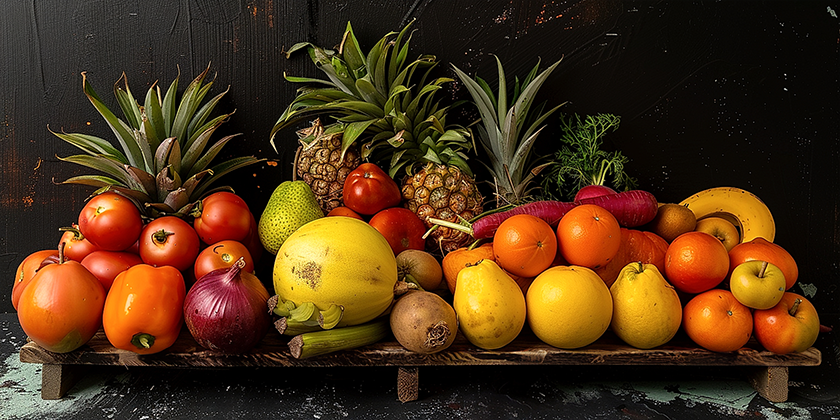Consumer behaviors and market dynamics are fundamentally changing.
The trend is increasingly shifting towards value-based pricing, especially in the agrifood sector.
However, understanding the complexities and intricacies of this pricing model can be challenging.
This blog post aims to unravel the concept by providing a clear, comprehensive overview.
It will delve into the key factors that enhance the value of produce, elucidating how it shapes the final product pricing.
The focus will also include the economic and consumer trends driving this shift in the produce industry.
Contents
Insights Into Value-based Pricing For Produce
1. Reflects Perceived Quality, Not Production Cost
When discussing value-based pricing for fresh produce, it is critical to understand that the pricing strategy considers the perceived quality of the produce and not necessarily the production cost.
This approach allows the price to serve as a reflection of the value it offers to consumers – the healthier, fresher, and more appealing the produce, the higher its perceived value, and consequently, the price.
With value-based pricing, the higher the perceived quality and value of the produce, the higher the price, irrespective of the production costs.
Understanding the consumer perception is key to setting the right prices for the produce.
It is believed that the shift towards value-based pricing can encourage better farming practices as farmers would aim to enhance the quality of their produce to fetch better prices.
Farmers wouldn’t concentrate solely on the minimization of production costs and maximization of yield but will focus on improving the quality of the farm produce.
For instance, the usage of organic farming techniques may help in enhancing the perceived quality and hence, the price of the produce.
Also, customers are usually more willing to pay a higher price for produce they perceive as being superior in quality, taste, or freshness.
This perception is created not only by the actual quality of the produce, but also factors such as branding, packaging, and sustainability practices.
This makes value-based pricing a win-win situation for everyone involved – the growers, the sellers, and the consumers.
Growers and sellers can recoup a premium for high-quality, sustainably sourced products, while consumers get products that align with their expectations and lifestyle choices.
The farm’s location, the cultivated produce type, and the available substitutes also play a crucial role in the pricing decision.
So, contrary to a cost-based method where expenses and profits drive the price, value-based pricing shifts the focus on positive consumer perception of the product.
Bearing in mind these aspects, adopting a value-based pricing strategy seems to be a viable approach to achieve better returns, enhance sustainability and at the same time provide consumers with a healthier choice of consumables.
2. Encourages Sustainable Farming Practices
Adoption of value-based pricing in the produce market heavily encourages sustainable farming practices.
This pricing strategy focuses more on the qualitative aspect of the products rather than the quantitative, and that includes the way the products are produced.
Consumers are gradually becoming more conscious about their impact on the environment and therefore, are willing to pay a higher price for sustainably sourced products.
The shift from volume-based to value-based pricing in the produce market serves as a catalyst for farmers to adopt sustainable practices.
Sustainable practices consider the long-term health of the land, reduce reliance on synthetic inputs, enhance biodiversity, and maintain the quality of the harvested produce.
Also, farmers who follow sustainable farming practices may see improved soil health, potential cost savings from reduced input use, and better resilience to the impacts of climate change.
Therefore, value-based pricing not only promotes sustainable farming but also have a positive impact on farms’ long-term profitability.
For farmers, this pricing structure may offsets the higher costs associated with sustainable farming practices, making these practices more economically viable and attractive.
More importantly, it contributes to a sustainable food system by harnessing the power of market demand to stimulate environmentally friendly farming practices.
This caters to the growing demand for more transparent and sustainable food options among consumers, increasing their willingness to pay a premium for such products.
Moreover, such a transition can improve the overall product quality, as sustainable farming practices often lead to the production of healthier and tastier produce.
In fact, for some consumers, the assurance that the product was produced using sustainable practices may be a more significant factor in their purchase decision than the actual taste or quality of the produce.
This, in turn, can lead to enhanced customer loyalty and ultimately, an increase in demand for sustainably produced goods.
In this way, value-based pricing serves as an effective incentive for farmers to transition towards more sustainable farming practices.
Overall, the increasing emphasis on value-based pricing in the produce market is a positive development that encourages sustainable farming practices and benefits both farmers and consumers in the long run.
3. Promotes Fair Trade in Supply Chain
One of the key aspects of value-based pricing for produce is its strong emphasis on fair trade in the supply chain.
This model ensures that everyone involved in the growing, harvesting, packing and distribution of the produce is adequately compensated for their hard work.
By putting the true value of the product at the forefront, value-based pricing highlights the importance of the often overlooked supply chain laborers.
When value-based pricing is used, farmers aren’t just given a fair deal, they’re also recognized for their role in providing high-quality, sustainable and ethically produced produce.
A major aspect of this is empowering small-scale farmers and traders who are often exploited in traditional market systems.
By adopting value-based pricing, businesses are essentially ensuring that fair trade practices are upheld along every step of the supply chain, contributing to a more equitable and ethical food system.
In fact, consumers appreciate products backed by fair trade practices due to the ethical implications involved.
They’re more likely to spend a little extra on produce that is not only high-quality but also supports social justice initiatives.
This means value-based pricing indirectly supports the fair trade movement by rewarding consumers for ethical purchasing decisions.
By doing so, it helps to make sustainability and fair trade practices a standard in the industry rather than an exception.
Going a step further, value-based pricing also opens up opportunities for more ethical trading relationships between businesses.
If a consistent value-based pricing ethos is shared among wholesalers and retailers, it can lead to long-lasting partnerships based on respect and fairness.
This leads to greater stability in the supply chain which ultimately translates to more consistent high-quality produce for consumers.
In other words, the competitive benefits of a value-based pricing strategy go beyond just profits – they extend to promoting fair trade, ethical business practices and sustainability in the entire agricultural industry.
So, while the upfront costs might be higher for businesses choosing to adopt value-based pricing, the long-term advantages such as customer loyalty, increased demand and the promotion of fair trade certainly outweigh these initial investments.
4. Deters Pricing Wars Among Farmers
In the agricultural industry, a significant aspect of value-based pricing is its ability to deter pricing wars among farmers.
Typically, in the conventional pricing model, farmers compete fiercely against each other for the lowest possible prices to attract customers.
This competitive strategy often leads to a vicious cycle where farmers continually undercut each other’s prices, resulting in reduced profitability.
The destructive nature of such pricing wars can potentially undermine the sustainability of farms, often forcing them out of business.
Value-based pricing, on the other hand, helps to prevent such fierce pricing competition among farmers by focusing on the value of their produce rather than the cost of production.
By aligning the price with the perceived value of the produce, it reduces the need for farmers to engage in damaging price wars.
This model encourages farmers to improve their farming practices and produce quality, leading to more sustainable agriculture practices and higher profitability.
It promotes healthier competition among farmers, where the focus shifts from pricing to increasing the value of their produce.
The value-based pricing model differs from traditional pricing models by aligning the price with the perceived value, and therein lies its potential to disrupt harmful competition.
This encourages farmers to invest in innovation, sustainable farming practices, and quality techniques to improve the value of their produce.
This drives a shift from a price-focused approach to a value-driven one.
It is important to note that the transition to value-based pricing may not be straightforward for all farmers, but the long-term benefits far outweigh the initial challenges.
Value-based pricing is a win-win strategy as it ensures a better return for farmers while offering consumers high-quality produce, leading to increased customer satisfaction.
In a world where sustainability and fair trade are becoming increasingly important, value-based pricing can play a significant role in promoting these objectives and transforming the agriculture industry for the better.
In the larger context, value-based pricing for produce could play a catalyst role in transforming the agricultural landscape.
5. Spurs customer loyalty, increases demand.
At the heart of value-based pricing in produce is not just the return for the farmer but also the fulfillment of the customer who buys and consumes the product.
The value that the customer perceives in the product not only influences their willingness to pay a certain price, but also intriguingly shapes their purchasing behavior over the long term.
Customers who perceive high value in produce they purchase from a specific farm or supplier tend to stick with the same source for their future needs, leading to a loyal customer base.
These loyal customers become less price-sensitive over time, and more inclined to support their favorite source even if prices are slightly higher than competitors, due to the perceived value they associate with the product.
The nature of value-based pricing goes beyond the sheer monetary transaction – it fosters a more profound connection between the producer and the consumer, rooted in shared values and convictions.
Moreover, this customer loyalty induced by value-based pricing has a positive spill-over effect on demand, ultimately contributing to a sustainable and profitable business model for the farmer.
As more customers become loyal supporters, the demand for a farmer’s produce increases, creating a virtuous cycle of growth and profitability.
Simultaneously, farmers loyal to sustainable practices and fair trade create a unique selling proposition (USP) that appeals to a segment of consumers who value these ethical aspects.
These customers, in turn, are willing to pay a premium for these values, further perpetuating the cycle of increased demand and loyalty.
It’s essential to recognize that the increase in demand is not merely due to the higher prices but mainly because of the ethical premiums attached to value-based pricing.
Customers are not blindly paying more; they are actively choosing to support farmers who adhere to sustainable farming practices and fair trade.
The spiraling demand and consumer loyalty do not happen spontaneously but are outcomes of several behind-the-scenes factors intrinsic to value-based pricing.
This pricing model encourages transparency, honesty, and accountability, all of which are appealing attributes to today’s conscious consumer.
In essence, value-based pricing transforms a traditionally transactional relationship between farmer and customer into a mutually beneficial, enduring partnership.
The relationship built on shared values and trust can stand the test of time and endure market fluctuations, ensuring continued demand and fostering customer loyalty.
The Bottom Line
Ultimately, the value-based pricing approach aids in highlighting the perceived quality of goods, breaking away from the conventional correlation with production cost.
It nudges farmers toward more sustainable practices, fostering environmentally conscious behavior in the agriculture industry.
By promoting fair trade, it ensures a level playing field within supply chains and discourages pricing wars among farmers, ergo contributing to economic stability.
Moreover, value-based pricing is instrumental in strengthening customer loyalty and augmenting demand.
This pricing model is, therefore, an effective tool in crafting a more sustainable, balanced, and equitable economic landscape.




